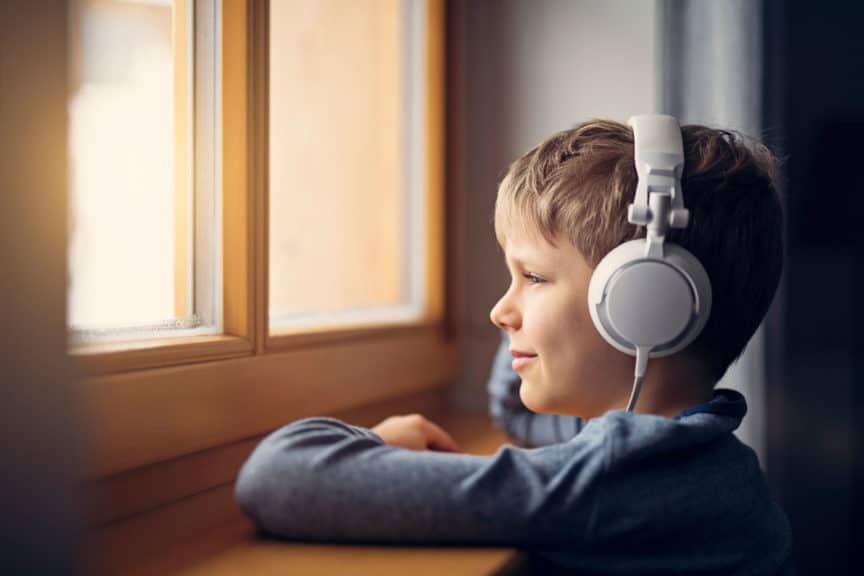More and more public places—like airports, schools, sports stadiums—are opening sensory rooms to serve people with special needs, specifically autism and sensory processing disorder.
When I attend or speak at conferences, I’ve noticed the workshop sessions that talk about sensory rooms are always well attended.
It seems everyone knows they have kids in their ministries who would benefit from a sensory room, but they don’t always know how to design and resource them.
It seems everyone knows they have kids in their ministries who would benefit from a sensory room, but they don’t always know how to design and resource them.
And sometimes people get stuck because they think they need a certain type of space, but there are all sorts of creative ways to utilize the space you have. Inclusion doesn’t have to be scary!
I’m going to try to give you some practical ideas for how to set up a sensory room, including budget, DIY, and blowout options.

Keep in mind that each sensory room will (and should!) look a bit different depending on the needs of your individuals.
Selecting a Sensory Room Space
First, let’s talk about room size. Size both does and doesn’t matter.
Here’s what I mean. A child who is in need of a sensory break could benefit from the corner of a larger room all the way up to a large room with multiple areas inside it, and everything in between.
You run into needing a specific space size when you have more and more students needing to use it at one time.
If you have one or two children who need a sensory break, you can use a corner space, a walk-in closet, or other very small space. You could even set up a tent in your room (more details on that later).
If you have 30+ students in your program who need a sensory room, a closet would not be helpful at all. Here’s my suggestion.
Figure out how many kids you have who need a sensory room now and double it. That will give you a good understanding of where you are and give you room for growth. (Especially since sometimes parents don’t share a child’s special need.)
A way to maximize space is to integrate some of the calm-down items into small groups or classrooms.
A way to maximize space is to integrate some of the calm-down items into small groups or classrooms.
You can have a bag with fidgets, weighted items, noise-cancelling headphones, and other small portable items that will allow the child to take a break without having to leave the room. Here are some other toys that can help.
This approach will leave your larger space available for a quiet tent or a crash pad.
Sensory Processing Issues
Once you’ve identified the space, think about what senses you want to give kids a break from.
In the case of many of our kiddos with sensory processing issues, they not only have difficulties with their 5 main senses, they also struggle with their proprioceptive (balance), vestibular (body awareness), thermoception (hot or cold), and nociception (pain) senses.
Who knew we actually have 9 senses?? What I’m going to do is take each of these individually and give you a list of items you may want to include in your sensory room space to help with those senses.
Sight
Let’s start with the sense of sight. Kids with disabilities can be over- or under-sensitive.
When it comes to sight, what we typically get is kids being oversensitive. They’re going to be super aware of fluorescent, bright, colored, or strobe lights.
For this reason, having a breakout room that makes use of natural light, incandescent lights, indirect lights, or other shaded light will help with the calming process.
This may mean that you turn the overhead lights off in your sensory room and just use lamps, lava lamps, or shaded lamps.
If you are lucky enough to have an IKEA near you, you might want to take advantage of their amazing floor lamps—they are a great fit for our sensory room.
Another great option is your local Goodwill or Salvation Army. They often have lamps available—you may just need to purchase a lampshade or put in a lower watt bulb to make it a great fit for your space.
Here are a few lighting options that tend to work well with sensory issues:
Hearing
The next sense we want to look at is hearing. Sensory kids may be either over- and under-sensitive.
Your under-sensitive kids may be completely zoned out and not seem to be hearing anything—not your voice or the voices/sounds around them.

Kids who are under-sensitive won’t necessarily benefit from a sensory break, but kids who are oversensitive definitely will.
Having noise-cancelling headphones, soft music, or a water feature can do wonders to help these kiddos manage the assault on their hearing.
Music
There are lots of music options, but I tend to favor classical or soft instrumental pieces.
If your church has a commercial license subscription (such as a Spotify Business Account) to play or stream music, put together a playlist for the sensory room.
When selecting options, use an infant as your guide. If the music is great for helping a baby go to sleep, then it’s more likely to be a win for kids who are extra sensitive to sound.
Headphones
Noise-cancelling headphones can be used in an integrated setting or a sensory room. The best deals I’ve found are on amazon any my local hardware store.
You can use the same type of headphones a construction worker uses—they typically have adjustable bands and removable foam. You can usually find them for less than $10.
Water Features
Water features are a fantastic calming option but can also be a double-edged sword.
If you have a child who obsesses over water, then definitely avoid water features as they will quickly become interactive! Not so conducive to a quiet calm space, but oh so fun!
Here are some examples:
Touch
The next sense we will look at is touch. For this one, you will need to provide for both over- and under-sensitive children.
Tents
Your kiddos who are oversensitive to touch may need a touch-neutral area. One way to provide this is to use a small child’s tent.
Now a tent is unique as it may actually help with three senses.
For sight, it may give them a visually neutral place to sit, for hearing it may give them a quiet place to escape from the noise and movement.
For touch, it gives them a neutral place to not be bumping up against other kids. Putting soft blankets or pillows inside further helps to make this space comfortable.
We had a child our KidMin who was so sensitive to touch that she wasn’t able to participate with any of the large group activities.

We were still able to share Jesus with her by having her buddy read the Bible story softly to her from outside the walls. It was a truly precious example of how God meets us right where we are.
An inexpensive DIY option is to create a tent be fastening a sheet over two chairs or two tables—it’s super easy and accomplishes the same thing as a more expensive version for your sensory room.
Use Beanbags and Pillows
A child who is under-sensitive may need a place to go to get squeezes or squishes. A great way to provide this is with beanbags and pillows.
It’s most helpful to give the under-sensitive child deep pressure or squeezes through diffused pressure, so having them sit or lay on a bean bag and then place a pillow over their legs gives better diffused pressure then pushing on their legs or arms directly.
Always start with soft pressure and build up to where the child feels comfortable or visibly relaxes.
Sensory Boxes
Another great DIY option is to make a sensory box. Use a clear plastic shoebox with a lid. Pick a filler (dry rice, dry beans, sand, small pom poms, popcorn kernels, marbles) and then add something for the child to find.
This may include little people figures, plastic bugs, or a small item that reinforces the Bible story.
Have the child use her hands to try to find the items hidden in the box. Be warned, if she really likes this kind of input, she may attempt to put her whole hand, arm, head etc. in the box.
Some examples:
Taste
I’m going to skip over taste as most of the time we aren’t providing food during church, and any accommodations will typically come from a caregiver.
Smell
When it comes to the sense of smell, you will need to be able to help support either over- or under-sensitive children. Kids with an oversensitive sense of smell will really need as neutral a space as possible.
There are many things that you wouldn’t realize even have a smell to them, but to our oversensitive littles they do—and it’s strong.
Here are some examples of items that are often placed in sensory rooms but shouldn’t be because of their smells:
- Play dough
- Lotions
- Shaving cream
- Bubbles
- Fabric softeners
- Detergents
The extent that you limit these items will depend on how strong the sensitivity is. Ask parents first and then see how the child reacts to your space.
For children with under sensitivity (and for some oversensitive ones), having a scented blanket, stuffed animal, or cloth is helpful.
For kids who are oversensitive, giving them one smell as opposed to many helps them stay integrated and for a child who is under-sensitive having a comforting aroma (lavender is most common, but it depends on the child) helps calm them.
Etsy has some great lavender sachets, and you can make them yourself very easily and inexpensively.
We had a child who loved the smell of clean clothes.
Every Sunday morning before he came to Sunday school, we would spray a small pillow with Downey fabric spray and let it dry. He knew that when he needed a scent break, he could come get his pillow and take a whiff.

Here are some examples:
Proprioception
Now we are getting into the more obscure—but still extremely relevant—senses. These sensitivities are very prevalent in our friends with autism.
Proprioception helps us to know where we are in space.
As you read this, you are probably sitting in a chair or some other seating apparatus, you can feel the chair under your legs and behind your back, you can feel your feet touching the floor.
These sensations are all a result of your proprioception.
In our friends with proprioception issues, this is completely out of whack. The only way they can figure out where their body is, is to keep moving it. This is, most often, why our kiddos with autism, ADHD, or ADD are so wiggly.
Weighted Objects
One of the best ways to help calm the wiggles is to use weighted objects. There are many ways to do this—schools tend to use weighted vests. There are also weighted blankets, but they can be spendy.
Hands down, the best item we’ve found to use in our children’s sensory rooms to help these guys feel grounded is weighted stuffed animals.
We’ve had such great results with this that we now have multiple weighted animals at all our church campus locations.
We include rules (must be sitting down, no throwing, etc.), but, without a doubt, these are highly effective in helping our wigglers and wanderers sit.
Wraparound Seats
Another great option to help with proprioception issues is a seat that wraps around them. This really helps their body know where it is by providing extra points of contact.
You only feel the floor under your tush and the sides of your feet when sitting cross-legged, so you will have a much better chance of sitting still when you can feel it under your whole back, legs, feet, and arms.
Bean bag chairs are a fantastic wraparound seat.
Crash Pads
Another great option for a breakout sensory room is a crash pad. Our kids with proprioceptive issues really benefit from it.
There are crash pads that places like Adaptivemall.com and Abilitations.com sell, but they are actually super easy to create. One option is to just pile a bunch (8-10) of bean bags in a corner. Super easy.
Another DIY crash pad option is to stuff a bunch of old pillows, stuffed animals, foam blocks, or anything that’s soft and fluffy into a duvet cover; put the stuffed duvet cover in an inexpensive inflated pool, and you have a crash pad to use. Super cheap and easy.
Here are some other options:
Balance
The vestibular system provides you with your sense of balance. If you have ever had vertigo or gotten car sick, you were feeling the effects of a compromised vestibular system.
This is a really easy sensory issue to address in our breakout rooms.
Jumping
Hands down the best vestibular activity is jumping. You can get a mini trampoline (many times found at thrift stores) or just let kids jump directly on the floor.
Jumping is the absolute best for helping our kids who crave vestibular input.
Twirling
Another great option twirling around. You and I will likely get dizzy, but these guys can twirl all day, every day.
One point of caution: make sure the child would benefit from this input. If they are oversensitive in their vestibular system and you start spinning them around, make sure you have a bucket nearby!!
If you have a child who is having a hard time settling down and seems to be “flighty,” start off by having them hold your hands and jump up and down 10 times.
It’s a great start and may mean that they can stay with the larger group without having to leave to go to the sensory room.
Some options include:
Swinging
An option that is great for the vestibular AND proprioceptive senses is the swing. Here are some examples:
Pain
The sense of pain is important for helping to keep children safe. Children with sensory issues either experience no pain or, conversely, the slightest touch can be extremely painful. This, of course, produces much confusion.
You may have a child who is oversensitive. In that case, they may not be comfortable around games or activities that require a lot of jostling.
Or they may begin to cry or become upset when another child touches them—even lightly.
The opposite is almost as problematic.
These children are under-sensitive and may cut themselves or even be walking on a broken foot and not realize it. You will not realize they are in pain unless you see them bleeding or limping.
There’s not a lot of adaptive equipment that will help with pain processing issues, so it’s important to make sure you don’t have any sharp corners but you do have a nice soft place for them to sit.
Thermoception
The last one to be aware of is another easy one to address. This is thermoception.
The main thing to be aware of in this is that the sensory kids have a hard time regulating their temperatures. To this end, having the sensory room be an air-conditioned or heated space depending on your climate is best.
When the adults in the room feel warm, a child with thermoception processing likely does too.
If the child wore a sweatshirt that day, and it’s getting warmer, ask the child to take it off instead of waiting for them to take it off independently.
When it’s a cold day and the child tries to go outside without putting on a coat, make sure they bundle up appropriately as they will likely not realize they are cold even once they get outside.
If you have a student with thermoception issues, you’ll likely see that he gets overheated in the large group room. He’ll need a space to cool down to avoid a meltdown—literally and figuratively.
Having a small fan will also be helpful in both the cooling down and generating white noise.
Some other great breakout room or sensory options are:
Creating a space where kids can get a break from the larger group is sometimes the difference between a successful Sunday morning and an epic meltdown.
So, there you have it. Creating a space where kids can get a break from the larger group is sometimes the difference between a successful Sunday morning and an epic meltdown.
The balance is encouraging them to be with peers as much as possible while still providing that escape when needed. Leave room for grace, for them . . . and for yourself.
And, if you enjoyed this article, check out 10 Practical Ways to Make Your Kids’ Ministry Disability Friendly. and How to Make Your Bible Lessons More Inclusive for All Abilities.

Did you know? David C Cook offers HeartShaper Children’s Curriculum, which includes special needs friendly activities that work well with all kids—each activity approved by special needs experts. Plus, HeartShaper offers free resources you can use in your ministry to kids with special needs. Check them out here!










